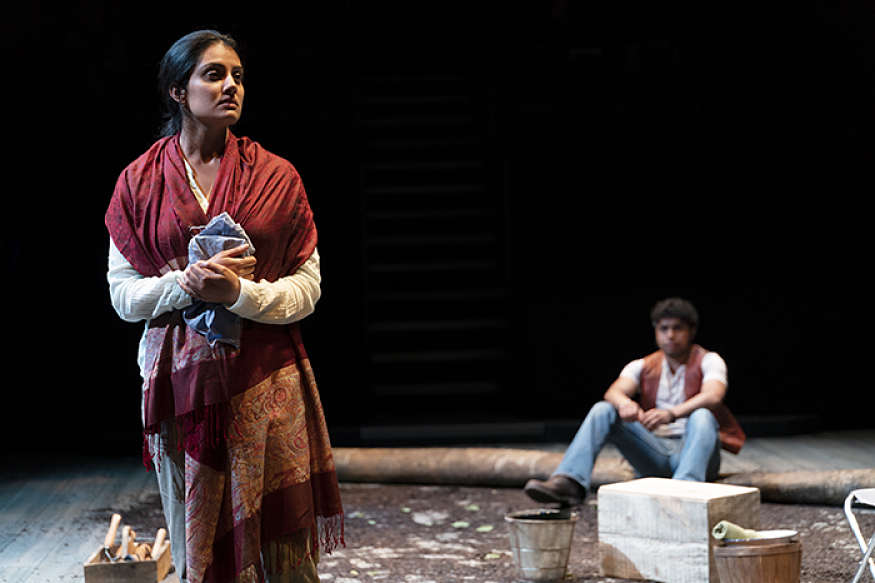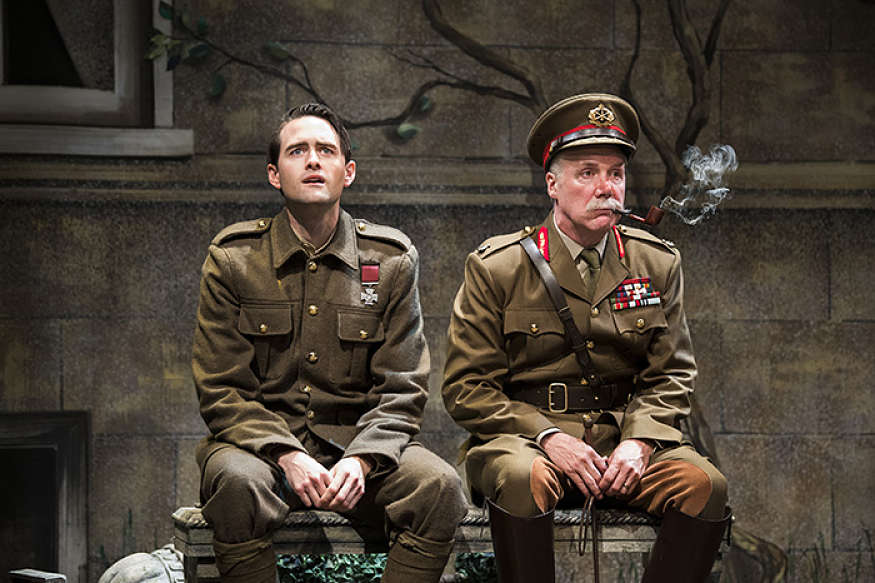Though so much of drama revolves around people feeling exactly the opposite, the theatre itself should be a place of welcome and inclusion. So it is at the Shaw Festival in tourist-friendly Niagara-on-the-Lake, Ontario, where artistic director Tim Carroll, now in the midst of his second season, hopes that every audience member who attends one of the season’s 14 plays experiences some sort of interaction with a company member: a performer, usher, house staff, or education staff.
Throughout the Shaw’s performance campus, you will hear talk of “two-way theatre” and the desire of Carroll (known as “TC” to company members and locals) to serve up not just exciting entertainment, but an experience that recognizes live theatre as a vibrant shared encounter.
“The direction of the festival is away from the kind of theatre I don’t like,” Carroll told me during a meeting last month in the festival’s library. “Which is simply treating the audience as consumers, and allowing the actors to do their play exactly the same every night without ever really having to take on board the fact that they’re in the room with 300 other people. I don’t think the festival [had been] that necessarily, but my whole work is to move away from that and to move in the other direction all the time. So for me, the vision is of a festival which has a reputation I’d like it to get: a reputation for being a place of real human meetings.”
He points to the nearly endless number of meet-up opportunities: the post-show talkbacks, the cocktail hours, the classes and clubs, the pop-up patios, the escape rooms, the speakeasy jazz nights, and garden tours, some of which are for friends and members only, many of which are open to all. “I think all of that is as much part of the Shaw experience as coming to the shows,” Carroll said. “People sign up for the whole ticket.”
Even those who don’t get a face-to-face encounter are invited inside via the company program bios, the majority of which are written in the first person and often touch upon how the subject cultivated a love of theatre. “I was born and raised in Scarborough, and my folks still live in the same house I grew up in,” reads the bio of Shawn Ahmed, a first year company member who plays the student Peter in The Orchard (After Chekhov). “When I go home I walk through the backyard where my sister snapped my first set of (super-cheesy) head shots. I watch movies and munch on chips in the basement where my brother and I would have epic soccer matches for out ‘family’s honour.’”
The shows bear out the Shaw’s welcome-mat directive. Company members of the lunchtime one-act O’Flaherty V.C. (one of three Shavian entries in the 2018 lineup) are onstage before curtain singing Irish ditties of the Great War and regaling us with lore of how the Victoria Cross—the V.C. of the play’s title—was melted down from Russian cannons during the Crimean War.
Younger audiences taking in the world premiere adaptation of C.S. Lewis’s The Magician’s Nephew arrive at the Festival Theatre even earlier to learn songs and make paper crowns, which they will don in the first act to become part of the action when Digory Kirke and Polly Plummer make their way to the blasted-out kingdom of Charn, en route to Narnia.
The opening of Sarena Parmar’s The Orchard (After Chekhov) includes an introductory recitation from the playwright (also a cast member), and a benediction from the character Charlie, a member of the First Nation upon whose land this tale is supposed to take place. (That part, as Parmar’s play shows, turns out to be debatable.) Canadian land barons, First Nation rodeo hands, and Japanese would-be cowboys are all working the same soil, side by side with a Sikh family who—unless they take proactive measures—will shortly lose their fruit orchards at auction. The multicultural nature of Parmar’s autobiographically inspired story puts a robust spin on Chekhov’s yarn of Russia’s dying and delusional aristocracy. In an interview Parmar told me that the audience decides on a nightly basis whether The Orchard is a comedy or a tragedy. Either way, Ravi Jain’s production is completely engaging.
Few of the characters in The Orchard feel especial welcome, or are welcoming to others. Half of its characters complain of being outcasts or outsiders. Michael Lopakhin, the would-be savior of the titular orchard, won’t pop the question to practical daughter Barminder, in part because he’s not wired for romance, but also because marrying a Punjabi would not help his social status. Housekeeper Donna has no use for the lovelorn ranchhand Yepi, longing instead for Yasha, who will dally with her clandestinely. Donna (like Yepi) is of Japanese descent, and in 1974, when the play is set, the memory of the World War II internment is not so distant.

But there was no question of welcome when it came to my stay, over three play-saturated days in late July. What I witnessed at Niagara-on-the-Lake is a festival that is actively using adventurous programming and its many avenues of outreach to simultaneously bring in new audiences and satisfy the festival faithful. I was also welcomed—or welcomed back—to a not-so-glorious post-war Ireland; to the unformed worlds imagined by C.S. Lewis, reachable only via the use of magical rings and winged horses; to Canada’s Okanagan Valley (by way of Bombay), and to 1928 Berlin, where the service at the Grand Hotel may be opulent but the guests and staff can’t easily dance or drink their troubles away.
My four plays included a short Shaw, a family-friendly adaptation of a literary classic, Parmar’s Chekhovian riff, and a musical, and I had barely taken an appetizer. The actor/writer Stephen Fry was at Shaw earlier in the summer, premiering the three-part solo performance Mythos, in which he spins tales of Greek gods and heroes. Sherlock Holmes was here in The Hound of the Baskervilles, along with Sarah Ruhl’s backstage romcom Stage Kiss and the Pygmalion-esque The Baroness and the Pig by Canadian Michael Mackenzie.
Festival 2018 paid extended homage to the centenary of the World War I armistice, most explicitly via O’Flaherty V.C., Joan Littlewood’s musical Oh What a Lovely War, and an adaptation of Shakespeare’s Henry V that finds a troop of edgy Canadian soldiers hunkered down in a dugout, acting out the Bard’s tale of patriotism before they are summoned into battle.

That venture into the breach, by the by, is a milestone: It’s the first time a work of Shakespeare has been produced at Shaw, which largely has maintained a gentleman’s agreement with the Stratford Festival 115 miles to the west to stay clear of its Bard brand. Since its founding in 1962 as a “salute to Shaw,” the festival has developed and refined its mandate to celebrate the works of its namesake, and, later, his literary contemporaries, but not his predecessors. It wasn’t until 2000 that the festival allowed contemporary plays set during Shaw’s lifetime. The programming of Henry V may have caused some festival purists to “reach for their smelling salts,” Carroll joked, but he has his justification at the ready. The Shaw’s rendition, from Carroll’s own concept, co-directed with Kevin Bennett, contains a regional overlay and a World War I setting. It constitutes an example of Shakespeare as Shaw might have envisioned it.
“I am shifting some of our focus; I am allowing us to look at pieces before Shaw’s lifetime,” Carroll said. “I don’t intend to do lots of Shakespeare here. I’ll probably never do another one at all, in fact.”
Or perhaps he will. Festivals change and evolve. Parmar’s The Orchard is the festival’s first offering by an author of South Asian descent. And come November, when the summer festival faithful have long since departed, the Shaw will kick back into gear with another milestone: its first winter offering, a version of Dickens’ A Christmas Carol.
But Dickens is for later. The summer is not over. It’s still Shaw time. How did the shows I saw measure up? O’Flaherty V.C., a one-act from 1919, is very Shavian in its agenda. Dennis (Dinny) O’Flaherty, a soldier who earns the highest honor bestowed by the British Army, the Victoria Cross, is the scion of a fiercely proud Irish mother whom he neglected to tell he was fighting for the Brits rather than against them. Returning home, O’Flaherty faces the wrath of his dame and the conniving of Tessie, the girl he wooed, who now seeks to a) spend his pension and b) get him to reenlist so he might pick up a second pension should he get wounded.
Thing is, O’Flaherty’s eyes have been awakened to the futility of combat. He has been a scoundrel—strangely, an honorable one. Yes, he received commendation for killing scores of Germans, but acknowledges that if he hadn’t, they would have offed him first. In short, life in peacetime is not so very peaceful. With every ironic realization that comes out of his mouth, the upper lip of his flummoxed friend and General Pearce Madigan becomes a shade less stiff. Shaw isn’t exactly celebrated for populating his plays with knock-down dragouts, but the four-person dust-up staged by fight captain Patrick McManus (who also plays the general) makes a nice mess of the stage before Ben Flanders’ O’Flaherty and the shell-shocked General return to wrap things up. “Some likes war’s alarums; and some likes home life,” the solider says. “I’ve tried both, sir; and I’m all for war’s alarums now.”

The canvas for The Magician’s Nephew is a different kind of mess: a playground filled with cardboard boxes out of which you could make practically anything. Digory, Polly, Uncle Andrew, and even the Cockney Cabbie and his horse Strawberry are as much the constructors of new worlds as Aslan the Lion, who literally sings Narnia into existence. A prequel to The Lion, the Witch and the Wardrobe (an adaptation of which Carroll directed at Stratford in 2016), The Magician’s Nephew contains a witch who is also a temptress, and a group of gentle, prelapsarian beasts in cardboard masks—no Disneyfication here. Indeed the production offers some elegant projections and puppetry, but is otherwise notable for the simplicity of its canvas. Welcome to the world of your own making, the company seems to be saying. Feel free to plant a seed. This is fertile soil. Something extraordinary is certain to grow.
Most members of the repertory company have two roles per season. As massive a figure as Deborah Hay cuts playing the witch Jadis in The Magician’s Nephew, she is positively sylph-like as the fading ballerina Grushinskaya (the Garbo role) in Grand Hotel, the final show on my dance card. Effecting an equally impressive transformation was Vanessa Sears, who went from the plucky adolescent sidekick Polly of Nephew to Flaemchenn, the pregnant typist with Hollywood dreams who can barely afford a drink at the Grand Hotel. Magnificently designed and danced with a flair that the work’s original director Tommy Tune would salute, Eda Holmes’s production for Shaw is a canny blend of glitz and decadence.
We begin in the ruins of the hotel only to watch it dreamed back into its heyday by the opium-induced hallucinations of a Colonel-Doctor. Those gilded walls may have seen their share of heartbreak and failure, but this is also a tale of renewed possibility: of fame, of wealth, of love, even of life. The tubercular bookkeeper Otto Kringelein is spun deliriously around on a carousel-like bar in the dance happy number “We’ll Take a Glass Together.”
Tragically, Kringelein drops his wallet. Miraculously, the destitute Barron von Gaigern elects to return it to him. By play’s end, Kringelein, now as high on life as he was on champagne, leaves the Grand Hotel for Paris. He is not drunk, but delirious with the notion of living to the fullest whatever time he has left.
I know how he feels. The Shaw Festival can have a similar effect. I’ll be back.
Writer, editor, and blogger Evan Henerson is based in Los Angeles.


